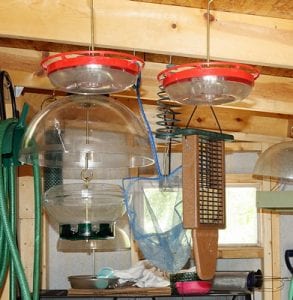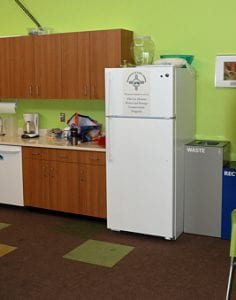
This page gives volunteers and staff some details on feeding hummingbirds at the nature center.
Hummingbirds are a delight for visitors to see in the summer months, and so we make a lot of effort to bring them into the observation area.
Feeding hummingbirds is one of the most labor-intensive feeding tasks from the late spring to the early fall, mostly because the feeders must be brought in to the shed every evening, or else raccoons toss them around at night. The hummingbird juice spoils rather quickly in the heat of summer, so it needs to be replaced every two or three days, and you need to know where to find unused nectar in the refrigerator or make some up if we are out.
Where you find the feeders: In the shed, hanging from hooks screwed into the overhead rafters. Or, if no one brought feeders into the shed the night before, you will need to hunt for them. Look first to see if they were left outside — look on the shepherd hooks, on the ground below the hooks, or over the fence rails to see if raccoons tossed them into the canyon below.
If they are not outside, maybe they were brought into the building. Look in the classroom, around the sink area, or near the back entrance door. If they are not there, then it’s a mystery, and you’ll have to ask someone.
What if the nectar needs replacing? You will need to refresh the hummingbird juice if the feeders are empty or if the juice is clouded or full of debris. In the summer, that may be as often as every other day, but in early spring or late fall, when the weather is cooler, they may go three or four days before needing new nectar.
There should be a bottle of fresh nectar in the refrigerator in the classroom. Look inside the shelves on the door, and/or look for a bottle labeled “hummingbirds.”
Before you put fresh nectar in a feeder, wash it out thoroughly. Check for any signs of black mold on the feeder or its ports and find a suitable brush to scrub it away. Then dry the feeder and add fresh juice, filling it up about halfway, depending on how active the hummingbirds are.

And what if there’s no fresh juice in the refrigerator? If you are comfortable doing so, make up some fresh juice. There should be some sugar in the cabinet above the sinks. The recipe is four parts of water to one part of sugar. Hummingbird juice is made with regular table sugar because that recipe most closely matches what they get from natural flowers. (Flowers make sucrose!)
It is best if the water is sterilized first — you can heat some up in the microwave, add the sugar to the hot water, and then you will need to let it cool down before you put it outside.
If you are uncomfortable making up the fresh juice, call Bob Walker and let him know we are out, and he’ll arrange to have some fresh juice made up for the next day.
Where do the feeders go outside? Hang them on the shepherd hooks in the back. One of them should go nearest to the observation window, so visitors can get a good closeup view of them feeding. Hang one or two more where there are other hooks outside.
